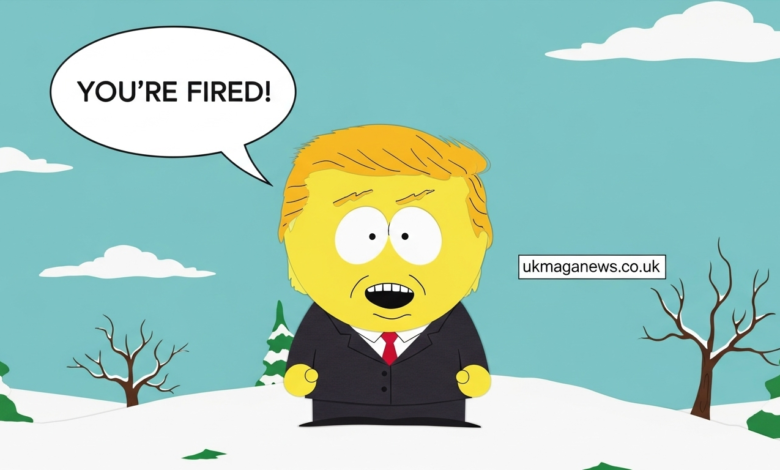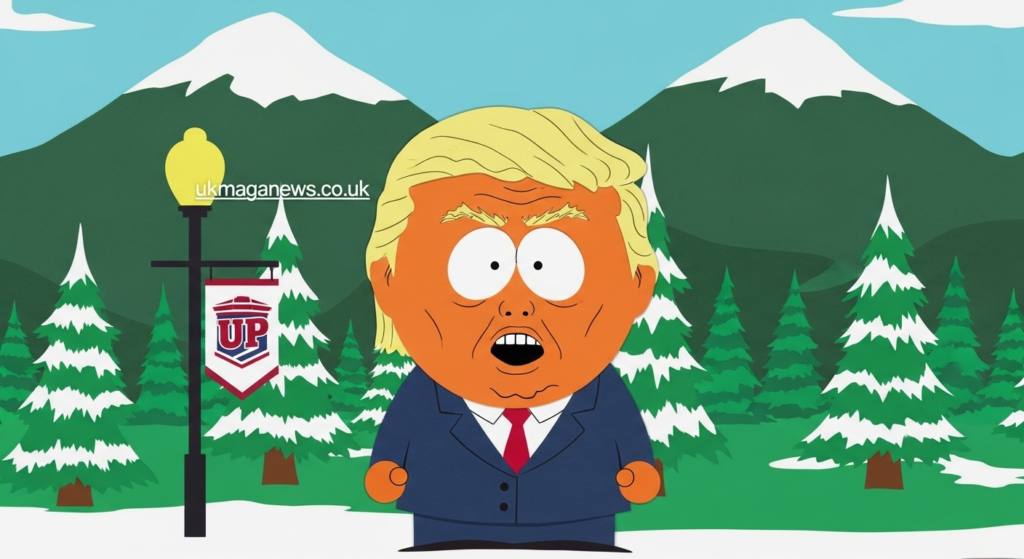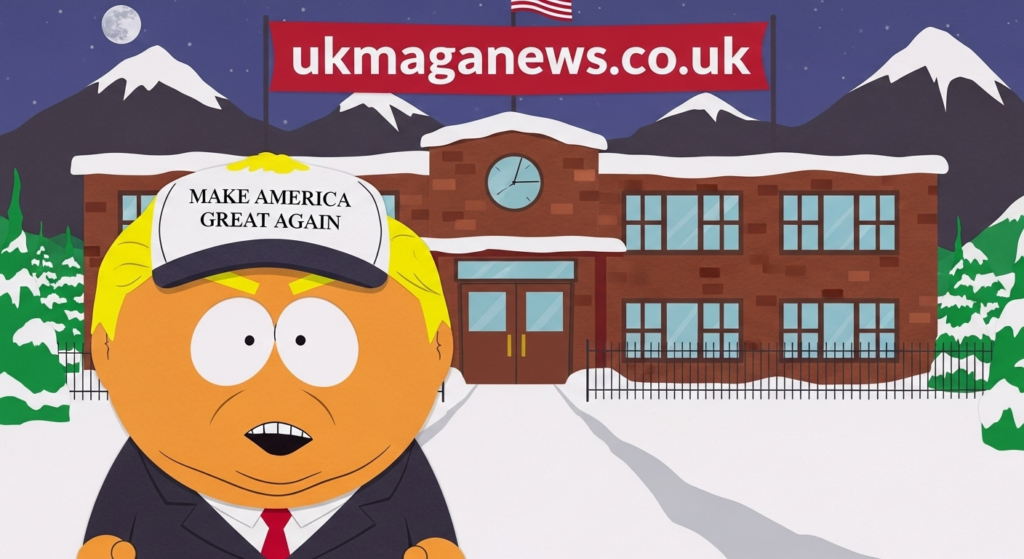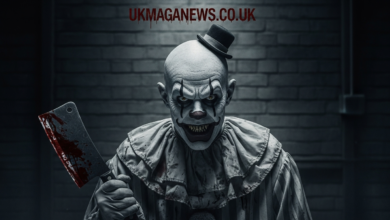South Park Trump: Brilliant Satire Controversy Unleashed

Introduction
You probably remember where you were during the 2016 election cycle. The political landscape was intense, divisive, and absolutely wild. In the middle of all that chaos, South Park did what it does best: it held up a mirror to society and made us laugh at the absurdity. The show’s treatment of Trump became one of the most talked about aspects of recent seasons.
South Park Trump episodes didn’t just mock a political figure. They captured something deeper about American culture, media obsession, and our collective response to unprecedented political theater. Whether you loved or hated the portrayal, you couldn’t ignore it. The show’s creators, Trey Parker and Matt Stone, took their satirical scalpel to the Trump phenomenon in ways that sparked conversations across the political spectrum.
This article explores how South Park handled Trump, the creative decisions behind the portrayal, audience reactions, and the lasting cultural impact. We’ll look at specific episodes, character choices, and why this particular satirical approach resonated or repelled viewers. Let’s dive into one of the most controversial satirical undertakings in recent television history.
The Origins of South Park’s Trump Satire
Early References and Build Up
South Park actually referenced Donald Trump long before his presidential run. The show mentioned him occasionally over the years, usually as a symbol of wealth or ego. These early references were throwaway jokes rather than sustained commentary. Nobody predicted he’d become a central figure in the show’s narrative.
When Trump announced his candidacy in 2015, the South Park writers faced a dilemma. How do you satirize someone who already seems like satire? Trump’s public persona was so outrageous that traditional parody techniques felt inadequate. The challenge was finding fresh angles on someone who dominated every news cycle.
Season 19 marked the beginning of South Park’s serialized approach to Trump and election politics. The creators decided to weave political commentary throughout entire seasons rather than containing it to single episodes. This structural change reflected how politics had infiltrated every aspect of American life.
The show’s writers initially seemed uncertain about how to handle Trump. Early portrayals tested different approaches and tones. Finding the right satirical voice for this unique political moment took experimentation and adjustment.
The Mr. Garrison as Trump Decision
Here’s where South Park made its most controversial creative choice. Instead of creating a Trump character, they transformed Mr. Garrison into a Trump proxy. This decision raised eyebrows and sparked immediate debate. Was it brilliant satire or a cop out?
The Garrison as Trump storyline began in Season 19 and continued through multiple seasons. Garrison, a longtime character known for inappropriate behavior and outrageous statements, suddenly started campaigning for president. His platform was deliberately absurd, often featuring the catchphrase about a certain demographic.
This approach allowed South Park to satirize Trump without directly animating him. The creators could explore Trumpian themes, behaviors, and political tactics through an established character. It provided creative flexibility while maintaining plausible deniability about direct mockery.
Some viewers found this brilliant. Others thought it was cowardly. The debate itself became part of the cultural conversation around the show. Matt Stone and Trey Parker later admitted that Trump’s actual election complicated their satirical plans significantly.
Why Not a Direct Trump Character?
Parker and Stone explained their reasoning in various interviews. They felt Trump was already so cartoonish that a direct parody would be redundant. Creating an animated Trump doing Trump things seemed pointless. The man’s actual behavior exceeded what satire typically accomplishes.
Another factor was unpredictability. Trump’s statements and actions changed so rapidly that scripting episodes weeks in advance became nightmarish. Using Garrison as a proxy gave them flexibility to respond to the general Trump phenomenon without being tied to specific events.
The decision also protected the show creatively. If Trump’s presidency imploded or succeeded in unexpected ways, having Garrison as a stand in rather than Trump himself provided narrative escape routes. They could separate the characters if needed.
Additionally, using an existing character allowed exploration of how normal people get caught up in extreme movements. Garrison’s transformation into a Trump figure said something about corruption, opportunism, and losing yourself to political theater. That layer wouldn’t exist with a simple Trump caricature.
Key South Park Trump Episodes and Moments
“Where My Country Gone?” (Season 19, Episode 2)
This episode marked the beginning of Garrison’s Trump transformation. It dealt with immigration through the absurdist lens South Park is known for. Garrison became furious about Canadian immigrants and proposed building a wall. Sound familiar?
The episode aired in September 2015, early in Trump’s campaign when many still considered him a joke. South Park recognized something the mainstream missed: Trump’s message was resonating with real frustrations. The satire acknowledged legitimate concerns while mocking the proposed solutions.
Garrison’s descent into demagoguery in this episode was both hilarious and unsettling. You watched a character you’d known for years transform into something darker. The metamorphosis served as commentary on how extremism takes hold.
The episode included one of South Park’s most controversial sequences, involving Garrison and a Canadian political figure. It was crude, shocking, and perfectly encapsulated the show’s approach to political satire. Nothing was too sacred or too shocking to explore.
“Member Berries” Arc (Season 20)
Season 20 dealt extensively with the 2016 election through the member berries storyline. These cute berries representing nostalgia and making America “member” what it used to be became a central metaphor. The connection to Trump’s “Make America Great Again” was obvious.
Garrison continued his presidential campaign throughout this season, saying increasingly outrageous things. The show depicted him desperately trying to lose the election, recognizing he was unqualified. Yet his supporters loved him more with each scandal. Art imitating life or predicting it?
The season explored media’s role in Trump’s rise. The show satirized how cable news covered every outrageous statement, providing free publicity. They highlighted the complicity of media organizations in creating the very phenomenon they claimed to oppose.
This arc showcased South Park at its most ambitious. Serialized storytelling allowed deeper exploration of complex themes. The member berries represented more than nostalgia; they symbolized willful ignorance and resistance to progress. The metaphor worked on multiple levels.
Post Election Episodes
When Trump actually won, South Park had to pivot quickly. The episode immediately following the election had been written assuming a Clinton victory. The creators literally rewrote and reanimated the episode overnight. That’s the challenge of satirizing real-time politics.
“Oh, Jeez” showed a stunned South Park dealing with election results. The episode captured the shock many Americans felt regardless of political affiliation. Even Garrison seemed horrified by his victory, screaming that he had no idea what he was doing.
Subsequent episodes dealt with Garrison as president. The show explored the chaos of the administration, the normalization of abnormal behavior, and exhaustion from constant controversy. Many viewers related to the characters’ fatigue from endless political drama.
Eventually, South Park seemed to pull back from Trump satire. Parker and Stone admitted the challenge of satirizing someone who defied satire. By Season 21, they reduced political content, suggesting even they felt overwhelmed by reality’s absurdity.
Cultural Impact and Reception
Viewer Reactions Across the Political Spectrum
South Park Trump content divided audiences in fascinating ways. Some conservatives appreciated the show mocking political correctness and liberal outrage. Others felt betrayed by what they saw as unfair attacks on Trump and his supporters. The show managed to anger everyone at different moments.
Liberal viewers had mixed reactions too. Some enjoyed seeing Trump’s absurdity lampooned. Others criticized the show for “both sides” false equivalency or not taking Trump’s danger seriously enough. South Park’s refusal to pick a side frustrated people wanting clear political statements.
The show’s irreverent approach to Trump mirrored its treatment of all politicians and sacred cows. Consistency is South Park’s brand. Yet the stakes felt different with Trump to many viewers. Comedy about a reality TV star president hit differently than jokes about conventional politicians.
Social media amplified reactions to South Park Trump episodes. Twitter exploded after each new episode with arguments about whether the satire was fair, funny, or appropriate. The discourse sometimes overshadowed the actual content. The show became a Rorschach test for political beliefs.

Media Coverage and Analysis
Mainstream media extensively covered South Park’s Trump satire. Think pieces analyzed every episode from multiple angles. The show’s cultural influence meant its political commentary became news itself. Entertainment and politics had fully merged.
Some critics praised Parker and Stone for bold satire during polarized times. Others accused them of irresponsible both-sidesism. Academic analyses explored the show’s satirical techniques and effectiveness. South Park Trump became a case study in political humor.
Conservative media outlets sometimes cited the show when it mocked liberals or political correctness. Liberal outlets highlighted episodes critical of Trump or his supporters. Everyone cherry picked moments supporting their worldview. The show’s complexity resisted simple political categorization.
International media also covered the phenomenon. Foreign outlets used South Park episodes to explain American politics to their audiences. The show became a cultural ambassador, translating American chaos through animated satire. That’s an interesting role for a crude cartoon.
Influence on Political Discourse
Did South Park Trump satire actually influence political opinions? That’s difficult to measure definitively. Comedy can reinforce existing beliefs more easily than changing minds. Still, the show reached millions and shaped conversations about politics and media.
The show’s “giant douche vs. turd sandwich” framing from earlier seasons resurfaced during 2016. This cynical view of electoral choice resonated with frustrated voters. Whether that cynicism was healthy or harmful remains debated. South Park contributed to that particular discourse.
By using Garrison instead of Trump directly, the show made broader points about demagoguery and political theater. The satire wasn’t just about one man but about systems enabling such figures. That’s more thoughtful than simple mockery, though perhaps less immediately satisfying.
Young voters particularly engaged with South Park’s political content. For many millennials and Gen Z viewers, the show was a primary source for processing political absurdity. That’s both empowering and concerning depending on your perspective. Entertainment as political education has limitations.
The Challenges of Satirizing Trump
When Reality Outpaces Satire
Parker and Stone openly discussed their struggle satirizing Trump. The president’s actual statements and actions consistently exceeded what satire could invent. How do you exaggerate someone already beyond exaggeration? This fundamental challenge plagued late-night comedians too.
Traditional satirical techniques depend on amplifying truth to reveal absurdity. But when the truth itself seems absurd, where do you go? South Park found itself in uncharted comedic territory. The normal rules didn’t apply to this particular subject.
The rapid pace of Trump news cycles created additional problems. By the time an episode aired addressing one controversy, five new ones had erupted. The show’s production schedule, even the accelerated South Park version, couldn’t keep pace. They were satirizing a moving target traveling at light speed.
This challenge ultimately led South Park to reduce its Trump and political content. The creators recognized they were fighting an unwinnable battle. Sometimes the best satirical response is stepping back and letting reality speak for itself.
Audience Fatigue and Controversy Overload
Many viewers experienced Trump exhaustion by 2017 and 2018. The constant controversy, news alerts, and political drama drained people. When South Park aired Trump-related content, some viewers tuned out. They wanted escape from politics, not more reminders of it.
This fatigue affected ratings and audience engagement. South Park had always been culturally relevant, but the Trump era tested viewer appetites for political content. The show walks a fine line between timely and tiresome. Finding that balance proved especially difficult.
Additionally, the polarized political environment made comedy riskier. Jokes about Trump weren’t just jokes; they were political statements that could alienate half your audience. South Park never worried much about alienating people, but even they felt the pressure. The stakes felt different somehow.
The creators eventually decided to “put down our tools” regarding Trump as Stone phrased it. They recognized the diminishing returns of continued Trump satire. Moving on preserved the show’s creative energy and avoided beating a dead horse. Knowing when to stop matters in comedy.
The Serialization Experiment
South Park’s shift to serialized seasons during the Trump era was ambitious. Previously, episodes stood alone with occasional recurring elements. Serialization allowed deeper exploration of themes but also created problems. If a storyline isn’t working, you’re committed for the whole season.
The Trump-driven serialization tied the show to political developments. This reduced flexibility and creative freedom. South Park’s strength had always been responding quickly to cultural moments. Serialization somewhat compromised that agility even as it enabled more complex storytelling.
Viewer reactions to serialization were mixed. Some appreciated the ambition and depth. Others missed the standalone episode format that allowed infinite reset possibilities. The show has since moved back toward looser continuity, suggesting the experiment had limitations.
The Trump era serialization remains a fascinating period in South Park’s history. It shows creators trying to adapt to unprecedented times. Not every experiment succeeds, but the willingness to evolve keeps the show relevant. That creative risk-taking deserves respect regardless of execution.
Comparing South Park to Other Trump Satire
Late Night Comedy Shows
Late night hosts like Stephen Colbert, Jimmy Kimmel, and Seth Meyers made Trump a nightly focus. Their approach differed significantly from South Park’s. Late night satire was more direct, more partisan, and more frequent. Every monologue featured Trump jokes.
South Park’s episodic nature meant less frequent but potentially deeper Trump commentary. While late night offered daily reactions, South Park could explore themes over entire episodes or seasons. Each approach had advantages and limitations. Frequency versus depth represents a fundamental trade off.
The animated format gave South Park freedoms live action shows lack. You can depict anything in animation without worrying about practical effects or actor limitations. This allowed more absurdist, extreme satirical scenarios. Garrison’s storylines went places live comedy couldn’t touch.
Audience expectations differed too. Late night viewers expected Trump content. South Park viewers wanted it sometimes but also craved the show’s broader cultural commentary. Balancing these expectations while maintaining creative integrity challenged the creators constantly.
Saturday Night Live’s Approach
SNL’s Alec Baldwin as Trump became culturally iconic. The impression captured Trump’s mannerisms, speech patterns, and personality. It was broad, accessible satire that millions enjoyed. Baldwin’s portrayal dominated pop culture discussions about Trump comedy.
South Park’s Garrison proxy took the opposite approach. Instead of mimicking Trump directly, they explored Trumpism through an existing character’s transformation. This was more conceptual, more abstract, and required more audience interpretation. Not better or worse, just fundamentally different.
SNL faced criticism for normalizing Trump by having him host in 2015. South Park never gave the actual Trump that platform. Using Garrison maintained critical distance while still engaging with the phenomenon. The creative choices reflected different satirical philosophies.
Both shows struggled with the same fundamental challenge: satirizing the unsatirizable. SNL leaned into impression-based mockery. South Park tried structural and metaphorical approaches. Neither fully cracked the code, suggesting the problem might be unsolvable. Some things resist satire by their nature.
The Daily Show and Animated Satire
Trevor Noah’s Daily Show took a news-parody approach to Trump. Clips of actual Trump statements juxtaposed with commentary created humor from reality itself. South Park couldn’t use that technique as an animated show. They had to create everything from scratch.
This fundamental difference shaped satirical approaches. The Daily Show let Trump’s words indict himself. South Park had to write dialogue that captured Trumpian absurdity without actual Trump quotes. Creating believable parody of someone already self-parodying is remarkably difficult.
Other animated shows like Family Guy and The Simpsons also addressed Trump. Their approaches varied, usually featuring direct Trump characters in guest appearances or cameos. South Park’s sustained serialized approach was unique among animated satire. The commitment was deeper even if execution proved challenging.
The variety of satirical approaches across different shows enriched public discourse. No single approach could capture every angle of the Trump phenomenon. Multiple perspectives and techniques created a fuller picture. South Park contributed one important piece of that larger satirical puzzle.
Long Term Impact on South Park
Creative Evolution and Lessons Learned
The Trump era forced South Park to evolve and adapt. The serialization experiment, the Garrison storyline, and the focus on political content all represented significant creative shifts. Some worked better than others, but all taught valuable lessons.
Parker and Stone became more cautious about extended political storylines. They recognized the risks of tying the show too closely to current events. While topicality is a South Park strength, it can also become a creative trap. Balance matters more than they perhaps realized.
The experience reinforced the show’s anarchic, irreverent identity. South Park works best when it refuses to be anyone’s political champion. The Trump years tested that independence as audiences wanted clearer positions. Maintaining neutrality amid demands for partisan commitment took courage.
Recent seasons show South Park returning to its roots somewhat. More standalone episodes, less serialization, broader cultural commentary beyond just politics. The Trump experience refined the creators’ understanding of what works for their show. Growth through challenge is valuable.
Relationship With Audiences
South Park’s Trump content affected its relationship with viewers. Some fans felt the show had changed too much or become too political. Others wanted even more aggressive Trump satire. Pleasing everyone became impossible, not that South Park ever really tried.
The show’s audience likely shifted somewhat during this period. Viewers exhausted by politics might have tuned out. Those hungry for political comedy might have tuned in. These dynamics affect the show’s cultural position and demographic reach. Comedy shows aren’t immune to political sorting.
Long time fans generally stuck with the show through creative experimentation. South Park had built enough goodwill over decades to weather controversial periods. That loyalty allows creative risks. Without established trust, the Trump era choices might have killed the show.
Moving forward, South Park faces questions about how to handle ongoing political chaos. Will they engage future elections as intensely? Probably not based on their stated intentions. The Trump era taught them limits of political satire in their format. That’s not failure, just recognition of reality.
Legacy in Satirical Television
South Park’s Trump satire will be studied for years as a case study in comedy during unprecedented times. It represents both the possibilities and limitations of animated political satire. The experimentation, even the failures, enriched the satirical landscape.
Future satirists can learn from South Park’s Trump era. The challenges of serialization, risks of over-commitment to current events, and difficulties satirizing reality-defying figures all offer lessons. Comedy evolves through trial and error. This was an important trial.
The show demonstrated that satire doesn’t always need clear heroes and villains. South Park’s refusal to moralize, even about Trump, was distinctive. Whether that approach is ultimately effective or responsible is debatable. But it represented a consistent philosophical position.
Twenty-five plus seasons and counting, South Park remains culturally relevant. The Trump years were just one chapter in a long story. How the show navigated that period adds texture to its overall legacy. The full impact won’t be clear for years, but it definitely mattered.
Conclusion
South Park Trump satire represents a fascinating intersection of comedy, politics, and cultural commentary. The show’s approach, using Mr. Garrison as a Trump proxy, was creative, controversial, and occasionally brilliant. It was also sometimes frustrating and ultimately unsustainable. The experiment taught us about satire’s limits in absurd times.
Whether you found the South Park Trump content hilarious, offensive, or somewhere in between, it sparked important conversations. The show held up a mirror to America during a bizarre period. That mirror was cracked and warped, as South Park mirrors always are. But it still reflected something true about where we were culturally.
The creators’ decision to eventually step back from Trump content was probably wise. Sometimes the best comedy comes from knowing when to move on. The Trump phenomenon will be analyzed for decades. South Park’s contribution to that analysis is one perspective among many, valuable precisely because it was different from everyone else’s approach.
What did you think of how South Park handled Trump? Did the satire work for you, or did it miss the mark? The conversation continues, which is perhaps the real measure of successful satire. It makes us think, argue, and reconsider our assumptions. That’s exactly what South Park has always done best.

Frequently Asked Questions
Why didn’t South Park create an actual Trump character?
The creators felt Trump was already so cartoonish that direct parody would be redundant. They used Mr. Garrison as a Trump proxy instead, believing this approach allowed more creative flexibility and made broader points about demagoguery beyond just one person.
What episode first featured South Park Trump satire?
“Where My Country Gone?” from Season 19, Episode 2, marked the beginning of Mr. Garrison’s transformation into a Trump-like figure. This episode aired in September 2015 during Trump’s campaign and dealt with immigration through South Park’s signature absurdist humor.
How did South Park handle Trump’s actual election victory?
The show had to completely rewrite and reanimate the post-election episode overnight since they’d assumed Clinton would win. The episode “Oh, Jeez” showed characters stunned by the results, with even Garrison horrified by his victory and claiming he had no idea what to do.
Did Trey Parker and Matt Stone regret their Trump storyline?
The creators admitted the challenge of satirizing Trump became overwhelming since reality exceeded satire. They eventually decided to reduce political content, acknowledging they struggled with the unpredictable news cycle and the difficulty of exaggerating someone already beyond exaggeration.
What are member berries in South Park?
Member berries were cute talking berries in Season 20 that represented nostalgia and making people “member” the past. They served as a metaphor for Trump’s “Make America Great Again” message and explored themes of willful ignorance and resistance to progress.
How did audiences react to South Park Trump content?
Reactions were deeply divided across political lines. Some conservatives appreciated mockery of political correctness while others felt unfairly attacked. Liberal viewers were split between enjoying the satire and criticizing the show for both-sidesism. The show managed to frustrate everyone at different points.
Why did South Park use serialized seasons during the Trump era?
The creators experimented with serialized storytelling to allow deeper exploration of complex political themes. However, this reduced their trademark flexibility and tied them to political developments, ultimately proving less sustainable than their traditional standalone episode format.
Has South Park completely stopped Trump references?
The show significantly reduced Trump and political content after Season 21, with creators stating they wanted to “put down our tools” regarding Trump satire. They haven’t completely abandoned political commentary but return to broader cultural satire beyond just one political figure.
What was the most controversial South Park Trump moment?
Many point to the crude scene in “Where My Country Gone?” involving Garrison and a Canadian leader as particularly controversial. The episode’s shock value and explicit content sparked significant debate about satire’s boundaries and appropriateness even by South Park standards.
Did South Park influence political opinions about Trump?
Measuring direct influence is difficult, but the show reached millions and shaped conversations about politics and media. Comedy typically reinforces existing beliefs rather than changing minds, though South Park’s cynical framing of elections contributed to broader discourse about political choices and frustration.Retry
Also Read ukmaganews.co.uk




